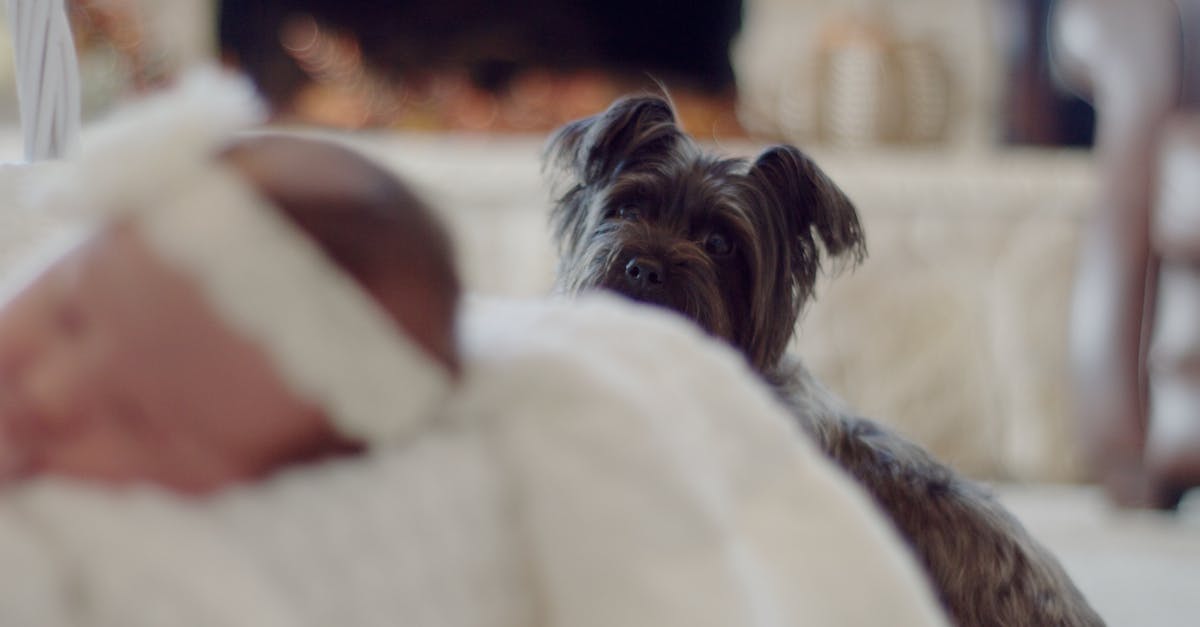Business
Introducing a New Puppy to Your Dog: Essential Steps for Success
Learn how to introduce a new puppy to your resident dog with these essential steps. Familiarize your dog with the new puppy’s scent before their first meeting. Use scent-marking techniques and pheromone-based products. Gradually introduce them in a controlled environment and choose a neutral territory. Observe body language and behavior for comfort levels and intervene if necessary. Establish ground rules and consistent training practices for a harmonious pack. Let’s create a well-behaved family!
Published
1 year agoon

Bringing a new puppy into your home can be an exciting and joyful experience. However, if you already have a resident dog, introducing them to the new addition requires careful planning and consideration. As an experienced dog owner, I understand the importance of a smooth and successful introduction between dogs. In this article, I’ll share my expert tips and insights on how to introduce your dog to a new puppy, ensuring a harmonious and happy coexistence between your furry friends.
Familiarize Your Resident Dog with the Scent of the New Puppy
Introducing a new puppy to your resident dog can be an exciting but potentially challenging experience. Dogs rely heavily on their sense of smell to gather information about the world around them, so it’s crucial to familiarize your resident dog with the scent of the new puppy before their first face-to-face meeting. Here are some essential steps to follow when introducing the dogs to each other:
1. Swap bedding and blankets: Start by swapping the bedding and blankets between the two dogs. This simple act allows them to become accustomed to each other’s scent in a non-threatening way. Place the blanket with the new puppy’s scent in your resident dog’s sleeping area, and vice versa. This scent exchange helps create a sense of familiarity and minimizes the initial shock of encountering a new smell.
2. Use scent-marking techniques: Dogs have scent glands located in various parts of their bodies, such as their paws and cheeks. By gently rubbing a cloth on the new puppy’s body and then rubbing it on your resident dog’s favorite toys or objects, you can introduce the scent in a controlled and positive manner. Your resident dog will begin to associate the new puppy’s scent with something pleasurable, strengthening their bond over time.
3. Apply pheromone-based products: Pheromones are chemical substances naturally produced by animals that can help promote a sense of calm and comfort. There are various pheromone-based products available on the market specifically designed to reduce anxiety and stress in dogs. Spraying these products in the environment where both dogs spend their time can help create a relaxed atmosphere during the introduction phase.
4. Gradual face-to-face introductions: Once your resident dog has become familiar with the new puppy’s scent, it’s time to proceed with face-to-face introductions. However, it’s essential to do this gradually and in a controlled environment. Start by allowing them to see each other from a safe distance, using a baby gate or a sturdy barrier. Observe their body language closely, assessing their reactions and making sure they are comfortable. If all goes well, gradually decrease the distance between the two dogs over a series of supervised, positive interactions.
Introduce Your Dogs in a Neutral Territory
When it comes time to finally introduce your resident dog and your new puppy, it’s important to choose a neutral territory for this initial meeting. This means selecting a location where neither dog feels a sense of ownership or territoriality.
Why is a neutral territory important?
Introducing dogs in a neutral territory helps to minimize any potential conflict between them. By removing any territorial behavior, you create an environment where both dogs can feel more at ease and open to establishing a positive relationship.
How to choose a neutral territory
Here are a few tips on how to select the perfect neutral territory for your dog’s first meeting:
- Go for a neutral outdoor space: Opt for a park, a quiet backyard, or any other open area where both dogs can explore freely without feeling confined.
- Ensure minimal distractions: Choose a location that is away from busy roads, other dogs, and noisy environments. This will allow your dogs to focus on each other without any unnecessary disturbances.
- Avoid your home: Even if you have a spacious backyard, it’s best to avoid introducing your dogs on your resident dog’s home turf. This can inadvertently trigger territorial behavior and make the introduction more challenging.
Remember, the purpose of this initial meeting is to allow your dogs to get acquainted and become comfortable with each other’s presence. By choosing a neutral territory, you’re giving them a blank canvas to start building a positive relationship from scratch.
How to introduce your dogs in a neutral territory
Now that you’ve chosen the perfect neutral territory, it’s time to introduce your dogs. Follow these steps for a smooth and successful introduction:
- Have separate leashes and handlers: It’s important to have two responsible people present, each holding a leash for one dog. This ensures that you can easily control any unexpected behavior and keep a safe distance if needed.
- Walk parallel: Begin by walking your dogs parallel to each other at a comfortable distance. This allows them to observe one another without feeling threatened or overwhelmed.
- Gradually decrease the distance: As the walk progresses, gradually bring the dogs closer together. Monitor their body language and behavior closely for any signs of tension or discomfort.
- Allow neutral interactions: Once the dogs have shown positive signs of curiosity or interest, you can start allowing them to sniff each other gradually and cautiously. Remember to always reward calm and friendly behavior with praise and treats.
Observe Their Body Language and Behavior
When introducing a new puppy to a resident dog, it’s important to closely observe their body language and behavior. Dogs communicate primarily through non-verbal cues, so paying attention to these cues can help you gauge their comfort levels and ensure a smoother introduction process.
Here are a few key things to look out for:
- Tail Wagging: A wagging tail can indicate excitement or happiness. However, it’s essential to understand that different tail wags can convey different emotions. A slow and low tail wag may suggest caution or apprehension, while a high and fast tail wag generally signifies enthusiasm.
- Ears: The position and movement of a dog’s ears can provide valuable insights into their emotional state. Erect ears facing forward indicate attentiveness, while flattened or backward-facing ears often indicate fear or nervousness.
- Posture: Dogs use their body posture to convey their intentions and emotions. A relaxed and open body posture, with a slightly wagging tail, indicates a friendly and approachable demeanor. On the other hand, a stiff or tense body, with a lowered head and raised hackles, may indicate aggression or discomfort.
- Vocalizations: Pay attention to a dog’s vocalizations during the introduction process. Whining, growling, or excessive barking can indicate anxiety or fear. It’s important to intervene if these vocalizations escalate or if you observe any signs of aggression.
- Eye Contact: Eye contact is another crucial aspect of canine communication. A soft, relaxed gaze often indicates a calm and friendly disposition, while staring or a fixed stare can be interpreted as a challenge or aggression. Avoid forcing eye contact between the dogs and allow them to establish it naturally.
Remember, each dog is unique, and their body language should be assessed in conjunction with their overall behavior. By closely monitoring their cues, you can gauge their comfort levels and intervene if necessary. The goal is to create a safe and positive environment for both dogs during the introduction process.
In the next section, I’ll provide some tips on creating a harmonious environment for the initial meeting between the new puppy and your resident dog.
Supervise Their Initial Interactions
When introducing a new puppy to a resident dog, it is crucial to closely monitor their initial interactions. This helps ensure the safety and well-being of both dogs and allows you to intervene if necessary. Here are some important things to keep in mind as you supervise their first interactions:
1. Take Note of Body Language: Pay close attention to the body language of both dogs during their initial interactions. Look for positive signs such as relaxed tail wagging, soft ears, and loose, wiggly body movements. Conversely, be aware of any signs of tension or discomfort, such as stiff body posture, raised hackles, growling, or excessive barking.
2. Set Clear Boundaries: Use your knowledge of your resident dog’s behavior and temperament to set clear boundaries for both dogs. Make sure they have enough space to move around and explore, but also establish limits to prevent any unwanted behaviors. For example, if your resident dog tends to guard its toys or food, provide separate areas for each dog during meal or playtime.
3. Allow for Gradual Interaction: Let the dogs interact in a controlled and gradual manner. Start with short, supervised sessions and gradually increase the duration as they become more comfortable with each other. Keep in mind that each dog may have different comfort levels and it’s important to respect their boundaries.
4. Intervene if Necessary: If you notice any signs of aggression or excessive rough play, it’s essential to intervene to prevent any harm. Use a firm, calm voice to interrupt the behavior and redirect their focus to something else, such as a toy or a treat. Separate them if needed and give them some time to calm down before trying again.
5. Reward Positive Behavior: Encourage and reward positive interactions between the dogs. Praise them and offer treats or playtime when they show signs of friendliness and cooperation. This helps reinforce positive behavior and creates a positive association with each other’s presence.
Remember, the initial interactions between a new puppy and a resident dog can be a crucial step in establishing a harmonious relationship. By closely supervising their interactions, setting clear boundaries, and rewarding positive behavior, you can create a safe and positive environment for both dogs to grow and bond together. Next, we will discuss some important tips for managing their ongoing relationship.
Gradually Increase the Duration of Their Interactions
After the initial introduction and successful neutral interactions, it’s time to gradually increase the duration of the interactions between your new puppy and resident dog. This step is crucial in building a positive and lasting relationship between the two.
Here are some tips to help you smoothly increase the duration of their interactions:
- Monitor their behavior: During each interaction, closely observe the body language and behavior of both dogs. Look for signs of relaxation and positive engagement, such as loose body language, wagging tails, and gentle play. On the other hand, be cautious of any signs of tension, like stiff body posture, growling, or avoidance.
- Set clear boundaries: To maintain a safe and harmonious environment, it’s important to set clear boundaries for both dogs. This includes establishing limits for playfulness, sharing toys or resources, and respecting personal space. Reinforce these boundaries consistently to avoid any potential conflicts.
- Allow gradual interaction: Start by allowing short periods of supervised interaction, gradually increasing the time as they become more comfortable with each other. This can be done in a controlled environment, such as a neutral outdoor space or a spacious room.
- Intervene if necessary: If you notice any signs of discomfort or tension during their interactions, it’s important to step in and intervene. Redirect their attention with a toy or treat, give them a break by separating them for a short while, or try engaging them in separate activities. Always prioritize their safety and well-being.
- Reward positive behavior: Whenever you witness positive behavior between your dogs, such as calmness, friendly play, or respectful interaction, make sure to praise and reward them. This positive reinforcement will encourage them to continue exhibiting good behavior towards each other.
Remember, the key is to take things slowly and let the dogs dictate the pace of their relationship development. Gradually increasing their interaction duration allows them to become more familiar and comfortable with each other over time.
By following these steps, you can ensure a smooth and successful introduction process between your new puppy and resident dog.
Address Any Relationship Issues
When introducing a new puppy to a resident dog, it’s important to address any existing relationship issues between the two dogs. This is especially crucial if the resident dog has a history of aggression, possessiveness, or dominance.
Here are some steps to address and potentially resolve any relationship issues between the dogs:
- Consult a professional: If you have concerns about the relationship dynamics between your resident dog and the new puppy, it’s advisable to seek guidance from a professional dog trainer or behaviorist. They will be able to assess the situation and provide tailored advice to address any specific issues.
- Separate and supervise: During the initial stages of their introduction, it’s essential to keep the dogs separated in order to prevent any potential conflicts. Use baby gates, crates, or separate rooms to ensure their safety and minimize the chances of aggression or dominance displays.
- Training and socialization: Consistent training and proper socialization are key to promoting a positive and harmonious relationship between the dogs. Both the resident dog and the new puppy should participate in obedience training sessions and interact with other dogs to improve their social skills.
- Establish clear boundaries: Clearly establish and reinforce boundaries for both dogs. This includes rules regarding toys, food, sleeping areas, and personal space. Consistency is crucial to ensure that both dogs understand and respect these boundaries.
- Positive reinforcement: Reward positive behavior from both dogs. Praise them when they interact calmly and peacefully. Use treats, toys, or verbal affirmation to reinforce positive behaviors and create a positive association between the dogs.
Remember, addressing any relationship issues between the resident dog and the new puppy takes time and patience. It’s important to tailor your approach to the specific needs and personalities of the dogs involved. By addressing and resolving any existing issues between the dogs, you can create a safe and harmonious environment for them to thrive in.
Provide Separate Spaces for Each Dog
When introducing a new puppy to a resident dog, it is crucial to provide separate spaces for each dog. This allows them to have their own territory and reduces the chances of any potential conflicts or territorial disputes. Here are a few key points to consider when creating separate spaces:
- Designated areas: Set up specific areas in your home where each dog can have their own space. This could be a separate room, a crate, or even separate sides of a room divided by a baby gate. Having designated spaces helps in establishing boundaries and promotes a sense of security for both dogs.
- Personal belongings: Make sure each dog has their own set of personal belongings such as toys, blankets, and bowls. This not only helps them feel comfortable in their own space but also prevents any resource guarding behavior, which can lead to aggression between the dogs.
- Feeding areas: It is crucial to have separate feeding areas for each dog. Feed them in their designated spaces and ensure that there is plenty of distance between their bowls. This prevents any food-related conflicts and allows each dog to enjoy their meal without feeling threatened or stressed.
- Supervised playtime: While it is important to provide separate spaces, it is equally important to allow supervised playtime between the dogs. This helps in building a positive relationship and promotes socialization. However, make sure that the playtime is supervised to prevent any potential issues from escalating.
Remember that the introduction process is gradual, and each dog should have their own space to retreat to if they feel overwhelmed or need a break. Providing separate spaces for each dog helps in creating a harmonious environment and allows them to adjust at their own pace.
By following these guidelines and providing separate spaces for each dog, you are setting them up for a successful and stress-free introduction. It is crucial to be patient, observe their behavior, and make adjustments as necessary. In the next section, we will discuss the importance of addressing any existing relationship issues between the resident dog and the new puppy.
Establish Ground Rules and Consistent Training
When introducing a new puppy to a resident dog, it’s important to establish ground rules and consistent training practices from the very beginning. This helps set a clear structure and expectations for both dogs, minimizing any potential conflicts down the road. Here are a few key steps to follow:
1. Reinforce Basic Commands
Start by reinforcing basic commands with both dogs individually. This means practicing commands like “sit,” “stay,” “come,” and “leave it” with each dog separately. This helps establish your authority as the pack leader and ensures that both dogs understand and respond to your commands.
2. Use Positive Reinforcement
Positive reinforcement is an effective training method that rewards good behavior. When one of the dogs behaves well or follows a command, reward them with treats, praise, or affection. This encourages them to repeat the desired behavior and helps strengthen the bond between you and each dog.
3. Set Clear Boundaries
Establish clear boundaries for both dogs, both in terms of their physical space and personal interactions. For example, designate certain areas of your home that are off-limits to the dogs, such as bedrooms or the kitchen. Also, establish rules regarding toys, food, and sleeping spaces to prevent any potential conflicts over resources.
4. Supervise Interactions
During the initial stages of introducing the dogs, it’s crucial to closely supervise their interactions. Keep both dogs on leashes and provide a controlled environment for them to gradually get acquainted with each other. Be vigilant for any signs of tension or aggression, and intervene calmly if needed. It’s important to prevent any negative experiences that could lead to fear, anxiety, or aggression in either dog.
5. Be Consistent
Consistency is key when it comes to training dogs. Stick to a set routine for both dogs, including feeding times, potty breaks, and exercise schedules. This helps them feel secure and know what to expect. Also, make sure that everyone in your household is on the same page and follows the same rules and commands for the dogs. This consistency creates a stable environment that promotes positive behaviors and reduces confusion.
By establishing ground rules and consistent training practices, you set the foundation for a harmonious and well-behaved pack. Remember, patience and consistency are key, and over time, both dogs will learn to coexist and even become best pals.
Conclusion
Introducing a new puppy to a resident dog requires careful planning and consideration. By familiarizing the resident dog with the scent of the new puppy before their first meeting, using scent-marking techniques, and gradually introducing them in a controlled environment, we can minimize any initial shock or discomfort for both dogs. Choosing a neutral territory for the introduction is crucial to prevent potential conflicts. Walking parallel to each other, gradually decreasing the distance, and allowing neutral interactions can help create a sense of familiarity. It’s important to closely observe the body language and behavior of the dogs during the introduction process to gauge their comfort levels. Establishing ground rules and consistent training practices, such as reinforcing basic commands, setting clear boundaries, and using positive reinforcement, will help create a harmonious and well-behaved pack. By following these steps, you can ensure a smooth and successful introduction between your new puppy and resident dog.
How can I introduce a new puppy to my resident dog?
To introduce a new puppy to your resident dog, start by familiarizing them with each other’s scents. Swap bedding and blankets between them, use scent-marking techniques, and apply pheromone-based products. Gradually introduce the dogs in a controlled environment, preferably in a neutral territory. Have separate leashes and handlers, walk parallel to each other, gradually decrease the distance, and allow neutral interactions.
Why is it important to introduce dogs in a neutral territory?
Introducing dogs in a neutral territory helps minimize potential conflict. Choosing a neutral outdoor space, ensuring minimal distractions, and avoiding the resident dog’s home can help create a balanced and fair environment for both dogs. It allows them to meet on neutral ground, reducing territorial aggression and establishing a more harmonious relationship.
How can I observe the body language and behavior of the dogs during the introduction process?
Observe the body language and behavior of the dogs during the introduction process to gauge their comfort levels. Pay attention to tail wagging, ear position, posture, vocalizations, and eye contact. These cues can indicate if the dogs are feeling relaxed, stressed, or uncomfortable. By closely monitoring their interactions, you can intervene if necessary and ensure the introduction process is going smoothly.
What should I do after introducing a new puppy to my resident dog?
After introducing a new puppy to your resident dog, it is crucial to establish ground rules and consistent training practices. Reinforce basic commands, use positive reinforcement, set clear boundaries, supervise interactions, and be consistent with your expectations. This helps create a structured environment and establishes a well-behaved pack, minimizing potential conflicts between the dogs in the future.
With over a decade of experience in the tech industry, Priya Sharma is a seasoned software engineer and tech blogger. She holds a Bachelor's degree in Computer Science from the Indian Institute of Technology (IIT) and has been a key contributor to cutting-edge projects in artificial intelligence and software development.

You may like
Mobility Scooter


Sideways Market: Navigating the Fluctuating Trends
Understanding Market Volatility Market volatility refers to the degree of variability in the price of a financial instrument within a...


Enhance Your iPhone with Adorable Cute Wallpapers
Looking to jazz up your iPhone screen with some cuteness? Discover the impact of adorable wallpapers on your device's look...


Glow Berry Prime: The Science Behind its Skincare Revival
Discover the transformative power of Glow Berry Prime in skincare with its potent blend of 20% Vitamin C, 2% Hyaluronic...


Glov Beauty: Eco-Friendly Products Review | Glov Beauty Reviews
Discover Glov Beauty's eco-friendly products like the Glov On-The-Go set with 500+ uses and the gentle exfoliation offered by the...


Unlocking Drake’s FPS Lyrics: How Gaming Influences His Music
Discover how Drake's lyrics in the first-person shooter-inspired track "War" reflect the influence of FPS games on his music. With...


Defeating a Fire-Breathing Dragon: Strategies for Mage Survival
Prepare yourself for an intense battle as we explore how to face a dragon capable of reaching temperatures over 2000°F....


Exploring Student Life at Glitties Eckerd College
Discover the dynamic student experience at Glitties Eckerd College with a plethora of club options, competitive sports, and community service...


Discover Success Stories with Money6x Real Estate Strategy
Discover the lucrative world of real estate investing with Money6x strategy! Uncover real-life success stories of investors achieving impressive 8-12%...


Get an Inside Look at Julion Alvarez’s 2024 USA Tour
Discover the meticulous planning behind Julion Alvarez's 2024 USA tour! Dive into the world of setlist curation, choreography design, and...


Enhancing Connections through Diversity & Active Listening
Learn how treating peers with empathy and actively listening can enhance relationships and boost innovation. The article emphasizes the significance...